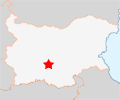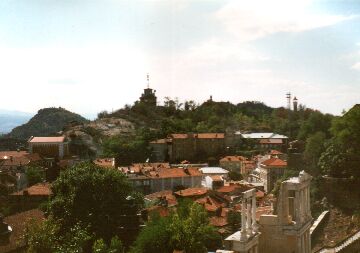Official Name
Пловдив (Plovdiv). This name probably derives from the Thracian name Pulpudeva, which again is the Thracian translation of the old Macedonian name Philippopolis. Before that, the place was known as Eumolpia. And that's not it: Slavic tribes transformed the old name Pulpudeva into Pyldin. However, the Ottomans preferred the Macedonien name and renamed it Philibe. The Romans wanted to have a word as well and called the place Trimontium - which means "three mountains". The recent name first came up in 1878 after the Russian victory over the Ottomans - they finally invented the name Plovdiv.
Location

| ||
| Plovdiv |
The town straddles the river Maritsa in the middle of the Upper Thracian Plain. Which is around 125 km south-east of the capital Sofia. Right in the middle of town, six characteristic syenite hills (syenite is slightly similar to granite) dominate the townscape. The Upper Thracian Plain is a very large valley between the Valley of Roses and the Stara Planina mountain range in the north and the Rodopi range in the south.
Population
About 350,000. Therefore, Plovdiv is Bulgaria's second largest city, but Sofia, the capital, is several times bigger.
Orientation
Plovdiv is quite easy to orientate, which is thanks to the river Марица (Maritza) in the north and several тепета (tepeta, hills) in the centre of town. The whole city is packed with historic buildings or at least their remainings. The main train station is in the south-west of town. From there, it's only a few hundred metres direction north-east to пл. Централен (pl. Tsentralen, Central square). When walking from there along vibrant ул. Княз Александър (ul. Knjas Alexandar (Prince Alexander st) to the north, you will get straight to the river Maritza. To be exactly, to a small bridge, where several booths line up. Actually there's not much to see on the other, northern side of the river. Most ancient ruins concentrate north-east of the modern city centre. Two of the six hills arise amid the old town - one is called Hill of the Liberators, the other one Hill of Youth. The centre itself is relatively new, but it managed to keep a certain charme.
History
First tribes settled in the area of present-day Plovdiv along time ago. The oldest excavations date back as far as 8000 years ago. Around the 5th century BC, a first Thracian settlement called Eumolpia was founded. But already during the 4th century BC, Philipp II, not less than the father of the famous Alexander the Great, King of Macedonia, destroyed Eumolpia just to found a new town, practically called Phillippopolis. This time, the town lasted a little bit longer, until the year 46 AD, when it was conquered by the Roman Empire. The town was renamed Trimontium and declared capital of Thracia. Trimontium flourished and had everything a typical Roman city was supposed to have: a stadium, monumental buildings, fortification systems and so on. However, together with the decline of the Roman Empire, Trimontium was about to face hard times. First, Slavic tribes overrun the town. Later on Proto-Bulgarians. Then the Ottomans. At least four times, cruisaders looted the town. It was not before the 13th century, that the town, now called Philibe, gained importance again as a major trading point.
Philibe flourished again during the national revival from 1840 to 1870. Virtually all merchants travelling between the Orient and Occident, between North and South, between India and Europe etc made a stopover in Philibe and let the town experience a new heyday. The Bulgarian middle classes were growing stronger and tried to express themselves using a certain architectonical style.
After the liberation from the Ottoman occupation by the Russians in 1878, the town was renamed a last time - 'Plovdiv', as it was called now, became the capital of East Rumelia. However, East Rumelia was not an independent state but just a semi-autonomous province inside the Ottoman empire. After the unification with the principality of Bulgaria in 1885, the capital was shifted to →Sofia. Which was bad luck for Plovdiv - eversince, it plays second fiddle in Bulgaria. In 1892, a first trade fair was held in Plovdiv. Which was a wise decision. The trade fair was a great success, and so Plovdiv became Bulgaria's main trade fair place.
Plovdiv has large industrial complexes, but the town doesn't forget about the importance of tourism - every year, hundred thousands of visitors find their way to Plovdiv.
Getting there / transportation
Plovdiv is also an important railway junction. Direct trains to the capital →Sofia are frequent and need two hours only. To →Burgas at the Black Sea Coast it's more than 4 hours. Trains running between →Belgrade and →Istanbul stop here as well. Additionally, local trains run to →Karlovo in the Valley of Roses, north of Plovdiv.
Buses from Plovdiv serve every major town in Bulgaria. They are often more convenient and faster than trains, which can be said about buses to international destinations as well. The bus terminal is just a few metres east of the main train station.
There are too many historic places and other sights in and around the old city centre to mention them all. More or less well preserved buildings from various epochs can be seen. Among the historic sites, there's an excavation area from a time when Plovdiv was still called Eumolpias - which was around the 2th century BC. The site occupies the top of a hill north-east of the centre, not far from the river. The place offers a nice view of the city. At the foot of the hill, there's the Ethnographical Museum and the highly interesting National Revival Museum, with both of them housed in remarkable bulidings. The splendid Church of Constantin and Elena in the vicinity was firstly built in the year 337, but it was destroyed several times. The present-day structure was completed in 1832.

| ||
| View from the Eumolpias ruins to the centre of Plovdiv |
West of the Eumolpias ruins and not far away, there's the Zarkva Sv. Bogorodiza (Church of the Holy Virgin) - the oldest preserved basilica of Plovdiv. From there, you can walk along ul. Saborna to the south-west. This road leads straight to pl. Stambolijski (Stambol square), which offers a well-preserved Roman Amphitheatre with around 3,000 seats and nearby Djoumaya Mosque. Another relict from Roman times can be found behing the main post office facing Central square - it's the so-called Forum Romanum of Plovdiv.

| ||
| Ancient Roman Ruins and one of the Syenite hills of Plovdiv |
Many visitors are disappointed at the traffic and the chaos in Sofia. This won't happen in Plovdiv. This town is a large open-air museum telling the history of Bulgaria almost without a hiatus. And - even at its more modern places, it offers a relaxed but cosmopolitan atmosphere. Additionally, the town makes a good base for trips to the Stara Planina and Rodopi mountain ranges.
Around 60 km north of the city, the small town →Karlovo and the magnificient Valley of Roses, not to talk about the Stara Planina mountain range behind the valley, are definitely worth a visit - especially in summer, when the (wild) roses grow. There's plenty to see in the south as well - as for instance magnificient →Bachkovo monastery (around 30 km) and, further to the south, the Rodopi mountains with →Smolyan as its local centre (80 km). 75 km north of Plovdiv, there's the very old town →Stara Zagora. A few kilometres west of Plovdiv, there's the small village Stamboliiski, where wine and rakiya are produced. It's even possible to see the wine production, but this should be arranged beforehand.
Private accommodation is probably the best and cheapest option. But there are also countless more or less expensive hotels - among them a 22-storey monstrosity called Hotel St. Petersburg, which is north of the river Maritza and a bit away from the centre. The rooms are okay, but prices are rather expensive today - a double will set you back around 90 Leva.
- www.plovdivcityguide.com As the URL already depicts...comprehensive city guide and web directory with useful news and information in English.
- www.plovdiv.org English version of one of the official websites of Plovdiv. Worth a look.
- bulgaria.domino.bg/plovdiv/ Very detailed website about Plovdiv. Bulgarian. The translation into English seems to be in progress.
Do you have or do you know a good website about Plovdiv? Don't hesitate, let me know! After checking it, I would love to add it to the link list. You can submit a link by using the →contact form. Note that commercial websites will be treated differently.
©2024 Europe-East.com

 Albania
Albania Bulgaria
Bulgaria